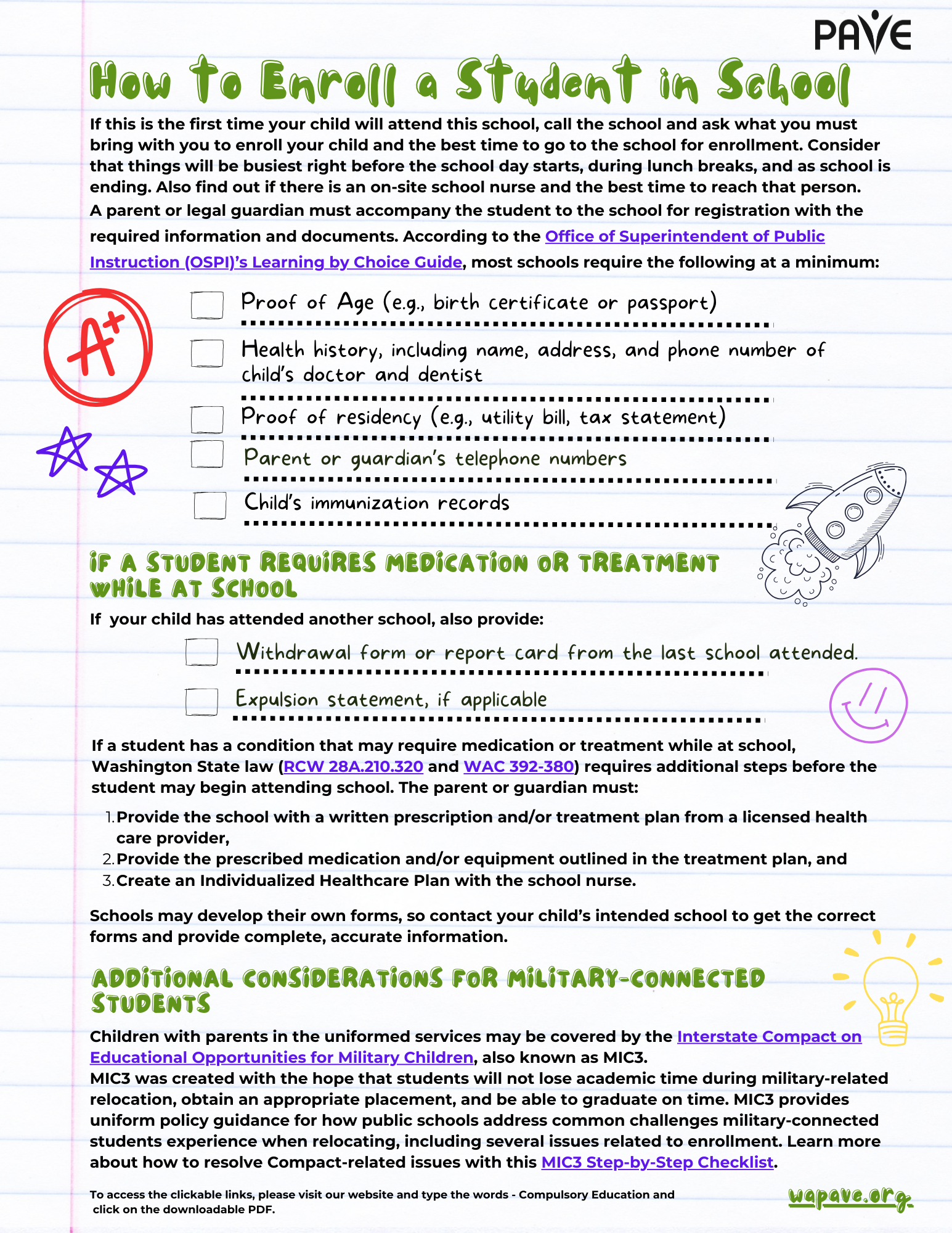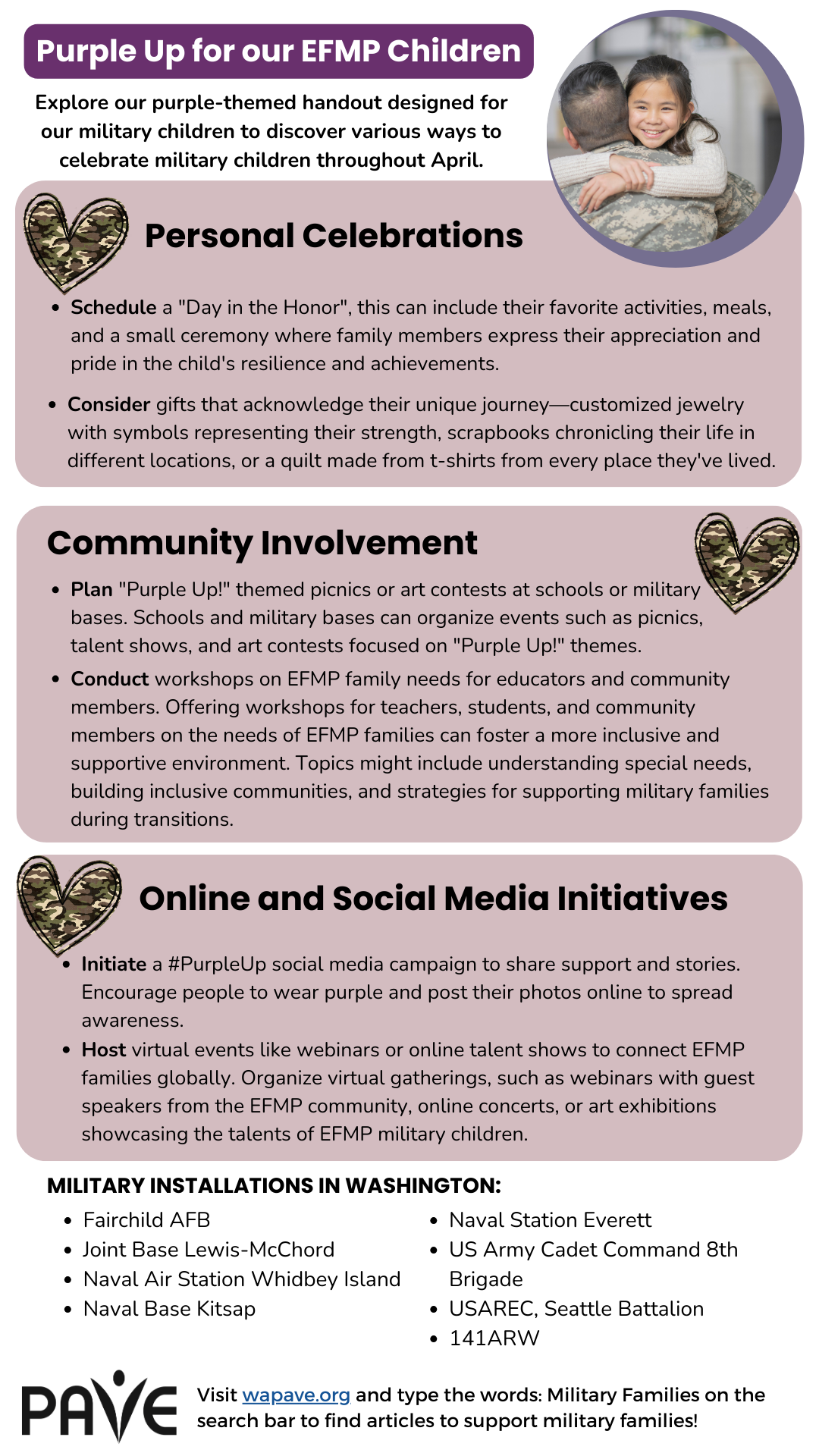When a military parent deploys, children—especially those with disabilities—may show changes in behavior, emotions, or learning. With the right support at home and school, these transitions can become opportunities to build resilience, confidence, and connection.
A Brief Overview
- Schools often notice changes in behavior when a parent deploys, and children with disabilities may feel deployment stress more deeply.
- The Emotional Cycle of Deployment provides a glimpse into the emotional journey families experience, offering insight into how children’s needs and feelings may shift throughout each phase of a parent’s deployment.
- Let the school know about an upcoming deployment as soon as possible. Sharing general information helps the school prepare while protecting mission details.
- Federal and state laws protect the rights of military-connected children during deployments.
- IEP or 504 supports may need updates to reflect emotional and behavioral changes.
- A deployment support plan should include warning signs, coping strategies, and contacts.
- School-based and at-home supports can help to support your child’s learning and emotional well-being during periods of service-related transitions.
- Planning for medical decisions during deployment is essential for children with disabilities.
- In Washington, some youth can make medical decisions starting at age 13; plan ahead for healthcare arrangements during and after deployment.
- The Deployment School Support Checklist, included in this article with download links in several languages, helps families track key steps and information to support a smooth school experience before, during, and after deployment.
- Teamwork between families and schools helps children feel safe, understood, and supported.
Why do schools need to know when a parent deploys?
Your children spend a large portion of their day in school, so teachers often notice changes or new behaviors. The value of parents and schools partnering to support military-connected children with the stressors of deployment is significant. As you know, having a parent away for a lengthy time places extra stress on children and the at-home parent, siblings and/or other care givers. No matter how often a military parent is deployed, and no matter how well-prepared a child might be for a parent’s absence, children with disabilities may be particularly vulnerable to the effects of stress on their physical and emotional well-being.
To ensure your child receives the appropriate support, it is important to communicate upcoming deployments with the school. Maintaining operational security (OPSEC) remains a priority during this process. The School Liaison and Exceptional Family Member Program (EFMP) Family Support office can provide guidance on how to share relevant information in a way that supports the child’s needs while safeguarding sensitive details. For National Guard families, your state’s Family Assistance Coordinator is also a valuable resource. You can find contact information for your School Liaison, EFMP Family Support office, and Family Assistance Coordinator by visiting Military Installations, a Military OneSource website.
What can you expect during deployment?
When a parent in the military gets ready to leave for deployment, it can be a big change for the whole family—especially for children. These changes often follow what’s called the Emotional Cycle of Deployment. This cycle includes different feelings that come and go before, during, and after a parent’s time away.
Here’s what that cycle looks like and how it might affect your child at school:
- Pre-Deployment: As families prepare for a parent’s departure, children may become anxious, clingy, or distracted. The change in routines can affect focus, emotional regulation, or behavior at school.
- Deployment: The first few weeks after a parent leaves are often the hardest. Children may show sadness, anger, or fear. They might miss their parent a lot and feel unsure about what’s happening. At school, this may appear as trouble paying attention, acting out, withdrawing, or feeling tired.
- Sustainment: As new routines form, children may feel more settled but still miss the deployed parent deeply. They might worry about their parent’s safety or feel left out when other kids talk about family events.
- Re-deployment: When the parent’s return nears, children may feel excited but nervous. Emotional ups and downs are common, and stress might spike again, making it hard to concentrate at school.
- Post-Deployment: Even joyful reunions can be stressful. Changes in rules or routines may cause confusion. It’s not uncommon for children to feel anxious or unsure about how to act around the returning parent.
Children with disabilities may experience these transitions more intensely. Changes in routine, caregivers, or emotional stability can significantly impact their learning and well-being. That’s why it’s essential for schools to be informed and prepared to offer consistent support throughout the deployment cycle. Teachers and staff can offer extra support, like checking in with the student, adjusting schoolwork, or helping them talk about their feelings in a safe way.
Know your student’s rights as a military child
Several laws—both federal and state—are in place to help protect the educational stability of military-connected students. These laws recognize the unique challenges your family may face during deployment or other transitions, and they’re designed to ensure that your child continues to receive the support they need when routines change or stress increases.
The Interstate Compact on Educational Opportunities for Military Children, commonly known as MIC3, allows schools to grant extra excused absences for children whose military parent is preparing for, returning from, or currently deployed in a combat or combat-support role. “Deployment” under MIC3 begins one month before the parent leaves and extends to six months after their return. You can request time off so your child can prepare, visit with the returning parent, or participate in family events. Approval is up to the school principal or superintendent and must balance academic needs with family well-being.
The federal Every Student Succeeds Act (ESSA) requires schools to identify students with a parent on active duty, including full-time National Guard or Reservists on Title 10 orders, using a Military Student Identifier. This helps educators make sure military-connected students don’t fall through the cracks by tracking academic progress and providing extra support when needed, such as during a deployment or family separation.
If your child has a disability, the Individuals with Disabilities Education Act (IDEA) and Section 504 of the Rehabilitation Act ensure that your child continues to receive appropriate services and accommodations, even when military life changes quickly. If deployment impacts your child’s behavior, emotions, or learning, their IEP or 504 team can work with you to update goals, supports, or strategies based on how your child is coping during this time. For example, if a child begins having more anxiety or difficulty with transitions due to a parent’s absence, breaks, visual supports, or check-ins with a counselor could be added to their services and supports.
Washington State law (RCW 28A.225.217) helps students stay in the same school during a parent’s deployment. If military orders require the custodial parent to relocate—including for deployment—the law allows the child to continue attending their current school, even if they temporarily live with a caregiver who isn’t the parent. This helps your child stay connected with familiar friends, teachers, and routines during a time of change.
Together, these laws help reduce disruption and protect your child’s education—keeping your family steady, supported, and connected wherever military life leads.
Communicate needs to the school
Communication about an upcoming deployment is key and setting up a meeting will help prepare the school. For example, you can request a meeting with your child’s teacher shortly after you find out about the upcoming deployment. If the separation is scheduled to start during summer vacation, you may want to book that conference as soon as possible after school begins. If your child is in middle or high school, meeting with every teacher might be a consideration as information may not reach each teacher who interacts with your child.
When meeting with your child’s teachers, you can let them know that there are some areas of information you won’t be able to share with them, due to operational security concerns regarding mission-related details.
Areas that can steer clear of mission-related operational security include:
- Timeframe – A general idea of beginning and ending dates. For example, “sometime this fall” or “around the end of the school year” is sufficient without revealing exact dates.
- Past experiences – If your child has experienced excessive stress during a previous deployment or their behavior reflects concern about the absence of a parent or changes in routine, this can help educators anticipate and respond to emotional or behavioral needs.
- Coping mechanisms – Sharing strategies that have helped your child manage stress. For instance, if your child finds comfort in looking at a photo of the deployed parent, a teacher may allow them to keep a copy in their backpack or desk.
- Temporary caregiving arrangements – Informing the school of any changes in guardianship, emergency contacts, or who is authorized to pick up your child during the deployment period.
- Support needs – Requesting access to school counselors, military family support groups, or academic accommodations to help your child adjust during the deployment.
- Reintegration preparation – Letting the school know that a parent will be returning soon (without specific dates) and that your child may need time to readjust emotionally or socially.
It can be helpful to keep a simple portfolio at home with samples of your child’s schoolwork, notes from teachers, and any behavior or support records from before, during, and after major changes—like a deployment or a Permanent Change of Station (PCS). This collection can help you and your child’s educators better understand how transitions affect learning and behavior over time. It also gives you a useful reference of what to expect and strategies that have been effective when preparing for future deployments or school meetings.
Consider sharing helpful resources with educators to deepen their understanding of military family challenges. The Military Family Research Institute at Purdue University developed a handout, How to Help Military & Veteran Families for Teachers, containing practical tips and information to support educators. The Department of Defense Education Activity (DoDEA) Office of Safety and Security developed a comprehensive tool for addressing the many challenges military children experience, called the Helping Hands Guide to Deployment for Educators.
Keeping a simple portfolio at home can be a valuable tool throughout your child’s deployment journey. Include samples of your child’s schoolwork, notes from teachers, and any records related to behavior or supports before, during, and after a deployment or move. This organized collection helps you and school staff track how your child is adjusting over time and better understand any challenges they face. It also provides a helpful reference when preparing for future deployments or school meetings, making it easier to spot patterns and share what strategies have worked well.
Develop a deployment support plan
Every child responds to stress in their own way—and those responses can look very different at home and at school. Your child may seem calm and well-adjusted at home, but still struggle emotionally or behaviorally in the classroom. That’s why it’s important to work with your child’s teachers and school staff to create a plan ahead of time.
A good plan should include:
Signs to Watch For
Work with teachers to identify behaviors that may signal your child is feeling overwhelmed, anxious, or upset. These might include sudden changes in mood, withdrawing from others, acting out, or difficulty focusing.
Steps to Take When Stress Shows Up
Decide together what actions the teacher or staff can take if your child appears to be struggling. This might include offering a break, using calming strategies, or allowing the child to visit a safe space like the counselor’s office or resource room.
Who to Contact
Make sure the school knows who to reach out to if your child needs extra support. This could be a parent, caregiver, School Liaison, or EFMP Family Support provider.
Tools and Strategies That Work
Share what helps your child at home—like using a fidget tool, listening to music, or looking at a photo of their deployed parent. Teachers may be able to use similar strategies in the classroom.
Check-Ins and Updates
Set up a regular time to check in with your child’s teacher or support team. This helps everyone stay on the same page and adjust the plan if needed.
School-Based Supports
Children with disabilities may qualify for extra support under an IEP or 504 Plan, especially during stressful transitions. Schools can provide services and supports to help students feel supported, stay focused, and succeed during a parent’s absence. Here are some examples:
Breaks and Safe Spaces
- Calm-down areas give your child a quiet place to go when they feel overwhelmed.
- Movement breaks or flexible seating can help kids who need to move or change positions during the day.
- Check-in/check-out systems let your child talk to a trusted adult at school each day to share how they’re feeling.
Emotional Expression at School
- School counselors or psychologists can meet with your child one-on-one or in small groups.
- Deployment support groups let military kids talk with others who understand what they’re going through.
- Creative activities like drawing, writing, or storytelling can help your child express feelings in a safe way.
Participation in School Activities
- Clubs and extracurriculars like music, robotics, or art can help your child feel connected and confident.
- Leadership opportunities such as student council or peer mentoring can build self-esteem.
- Buddy systems pair your child with a classmate to help them feel less alone.
At-Home Supports
Your child’s needs don’t stop at the school gate. These resources and strategies families can help children cope with the challenges of deployment:
Mental Health & Counseling
- Military & Family Life Counselors (MFLCs): Free, private help for children and families to talk about feelings and changes. MFLCs may be available on campus if the school is located on or near an installation.
- TRICARE Mental Health Services: May cover therapy and counseling for eligible military families.
- Telehealth Counseling: Online therapy options for families in remote areas or with busy schedules.
Tutoring Help
- Tutor.com for Military Families: Free, 24/7 online homework help in all subjects.
- School Tutoring Programs: Ask your child’s school about after-school academic support.
- Peer Tutoring or Study Groups: Older students may benefit from learning with classmates or mentors.
Activities and Recreation
- Youth Sports and Recreation: On-base programs like soccer, dance, or swimming—often free or low-cost.
- Family Walks or Outdoor Play: Simple daily activities to reduce stress and build connection.
- Base or Community Centers: Offer structured physical activities like martial arts or fitness classes.
Family Support Tools
- Sesame Street for Military Families: Videos, storybooks, and games to help young children understand deployment and other changes.
- EFMP & Me: An online tool for families in the Exceptional Family Member Program to plan for services and transitions.
- Military Child Care in Your Neighborhood (MCCYN–PLUS): Helps families find affordable, high-quality child care when on-base care isn’t available.
- The Child Care in Your Home (CCYH) pilot program: In select areas (e.g., Seattle/Tacoma, WA), this program offers fee assistance for full-time, in-home care. Families can hire a caregiver, including nanny-sharing or live-in options. The pilot is funded through September 2027.
Medical Decision-Making Rights
For students with disabilities, planning for medical decision-making before deployment helps ensure continuity between health and school supports. In Washington State, youth age 13 and older can consent to certain types of care without a parent’s permission, such as outpatient or inpatient mental health treatment and substance use services. Before you deploy, set up legal tools like a medical power of attorney or healthcare proxy so caregivers can access care quickly. Coordinating with doctors, legal advisors, and school staff ahead of time helps avoid delays that could impact your child’s health and education.
When your child turns 18, they legally take control of most medical decisions. Without formal arrangements like guardianship, conservatorship, or power of attorney, parents lose access to medical records and the authority to make healthcare choices. Supported decision-making is another option that allows adults with disabilities to retain their rights while receiving help from trusted supporters to understand and communicate decisions—but it does not grant legal authority unless paired with additional agreements. For students with disabilities, who often rely on coordinated medical and educational supports, this transfer of rights can be especially challenging. If your child is approaching adulthood, begin planning early to ensure trusted adults can support their care.
Deployment School Support Checklist
The Deployment School Support Checklist is a practical tool to help families stay organized and proactive throughout each stage of a deployment. It outlines key steps and communication tips to support your child’s learning and well-being tips while giving you space to track tasks and make notes to share with your child’s school.
Download the Deployment School Support Checklist:
English | German Deutsch | French Français | Spanish Español | Tagalog
Final Thoughts
Supporting a child with disabilities during a parent’s deployment takes planning, flexibility, and teamwork. You don’t have to figure it all out on your own. Partnering with your child’s school, building a support network, and making a personalized plan can help your child feel secure, supported, and ready to learn.
To further support your child’s education during deployment, you can also connect with your state’s Parent Training and Information (PTI) Center. Every state has a PTI dedicated to helping individuals with disabilities, ages 0-26, and their families navigate education systems. Families living in Washington State—or those PCSing in or out of the state—can submit a Support Request to PAVE for personalized support. If you live in another state, you can find your local Parent Center at ParentCenterHub.org.
Learn More
- Plan My Deployment (Military OneSource): Create personalized checklists and timelines to help your family prepare for each phase of deployment.
- Helping Children Cope (Military OneSource): Offers tips and resources to support your child’s emotional well-being before, during, and after deployment.
- DoDEA Helping Hands Guide: Provides strategies and tools for educators to support military-connected students facing deployment-related challenges.
- Helping Teachers Support Military Families (Military Family Research Institute – MFRI): Equips school staff with practical insights to better understand and assist military and veteran children in the classroom.
























